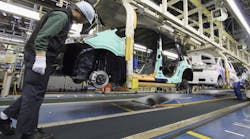TOYOTA CITY, Japan — Toyota City stands as a testament to the meteoric rise of its namesake, now the world’s biggest carmaker with record profits and sales of more than 10 million cars globally last year.
But this sprawling city of 422,000 people, just east of the industrial center Nagoya, was once a struggling textiles town called Koromo whose inhabitants depended on silk production to make a living.
Times got tough for the little community as the sector began to decline from the end of World War I, and it was further shaken by the 1923 Great Kanto Earthquake, which took 140,000 lives across the country, as well as the Great Depression six years later.
By 1933, as Japan focused on bolstering its domestic industries and imperial ambitions, Kiichiro Toyoda decided to build automobiles with the same pioneering spirit as his father Sakichi, who invented the automatic loom.
But where could he build a factory big enough to roll out cars? A string of communities were interested. In a stroke of fate, Koromo got the nod for its cheap land and nearby transit links — and the enthusiasm of the town’s then-mayor who faced off with skeptical local landowners.
“At that time, people didn’t really believe in the auto industry but he (the mayor) had the right intuition,” a municipal official said, adding that the sector was “crucial for the city’s prosperity”.
And on August 28, 1937, “Toyota Jidosha Kogyo” (Toyota Automotive Industry) was born, and a 495,000-square-meter (5.3-million-square-foot) factory big enough for 5,000 workers opened the following year.
More than Just Cars
While the Corolla and Prius hybrid maker now has plants in every corner of the globe, Toyota City still has a total of 10 factories building cars and parts in the city proper and surrounding area.
There are about 70,000 local people working for Toyota in the area, many whose parents or grandparents also relied on the giant company for a paycheck, with about 40% of local employees working in the auto sector.
So it seemed appropriate that, in 1959, the town changed its name to Toyota-Shi, or Toyota City in English, although that was a controversial move at the time — and the current mayor says his community is about more than just one industry.
“It is true that this is the city of the car — the name speaks for itself — but that isn’t everything,” Toshihiko Ota said. “We are the leading producer of rice in Aichi prefecture and we also grow grapes and pears. Toyota City has many faces, which is sometimes masked by cars.”
But the reality is, despite efforts to diversify the local economy, it is still heavily dependent on Toyota and local suppliers, with the company’s subsidiaries also involved in real estate, tourism and insurance.
“When Toyota coughs, the whole city catches a cold” is a common phrase, a point underlined during the 2008 financial crisis that saw Toyota lay off thousands of temporary employees, while tax revenue from the company temporarily dipped.
“The atmosphere was morose," Ota said. "It depressed the entire region."
Still, the city avoided the fate of another auto city, Detroit, whose declining fortunes saw it declare bankruptcy two years ago.
And with the recovery came a renewed optimism for Toyota City, beefed up by municipal projects including new schools and hospitals ... sponsored by Toyota.
By Anne Beade
Copyright Agence France-Presse, 2015




